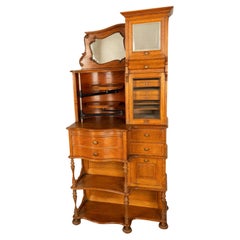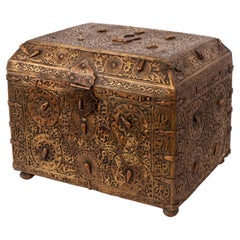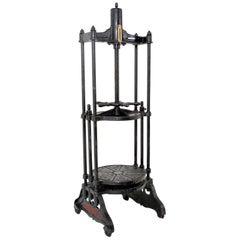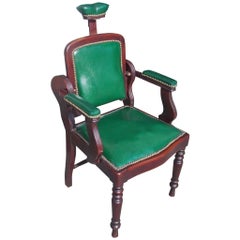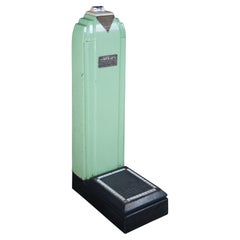Bloomsbury Fine Art & Antiques Scientific Instruments
to
2
3
3
1
1
2
2
1
1
1
1
1
1
1
1
1
3
3
3
Antique American Ransom & Randolph # 65 Carved Oak Dental Cabinet Toledo OH 1900
Located in Portland, OR
Antique American carved oak dental cabinet manufactured by The Ransom & Randolph C., Toledo Ohio, Circa 1899.
Arguably one of the best dental cabinets ever made, with so many unique features (and forgive the pun) cutting edge technology of the late 19th century. This cabinet was patented in 1899 and made of solid quarter sawn oak throughout, with carved accents above the beveled shaped mirror and carved & pierced brackets to the base with turned ribbed column supports.
The cabinet has a removable travel drawer case for making house calls, to the top of the case is a brass carrying handle and a brass plaque with the manufacturers name and "Patent applied for", making this one of the earliest manufactured of this model. The cabinet has paneled sides and a paneled back, the front is fitted with cupboard with two adjustable swing out arms with revolving circular trays. Below, the cabinet is fitted with serpentine shaped drawers to the front, a lift up mirror to the top right hand-side enclosing a stepped...
Category
Antique 1890s American American Craftsman Scientific Instruments
Materials
Mirror, Oak
Antique 16th Century Islamic Safavid Al Jazari Combination Locking Brass Casket
Located in Portland, OR
A highly important engraved Islamic combination locking brass casket, based on a design by the 12th Century Arab inventor & artist Ismail Al Jazari. Circa...
Category
Antique 16th Century Iraqi Islamic Metalwork
Materials
Brass
$24,500 Sale Price
30% Off
Antique Working English Cast Iron Cheese Press Thomas Corbett of Shrewsbury 1880
Located in Portland, OR
A rare antique and all original fully functioning cast iron English cheese press, by Thomas Corbett of Shrewsbury, circa 1880. This cheese press has just ...
Category
Antique 1880s English Industrial Scientific Instruments
Materials
Iron
$3,680 Sale Price
20% Off
Related Items
American Mahogany and Leather Dental Arm Chair, Circa 1840
Located in Charleston, SC
American mahogany and leather dental arm chair with adjustable back and head support, terminating on turned bulbous legs. Mid 19th Century
Category
Antique 1840s American American Empire Armchairs
Antique Toledo 8400A American Art Deco Green Enameled Porcelain Penny Coin Scale
By Toledo Scale Company
Located in Dayton, OH
Toledo Scale Company Model 8400A. Features an enameled green porcelain finish and tiled station. Features the iconic Art Deco Skyscraper design with a ...
Category
Early 20th Century Art Deco Scientific Instruments
Materials
Metal, Enamel
$1,080 Sale Price
20% Off
H 43.5 in W 11.5 in D 22 in
Cast Iron Mortar from USA
Located in Sagaponack, NY
A cast iron mortar with a bas-relief band in the center.
Category
Antique 19th Century American Industrial Planters and Jardinieres
Materials
Iron
Antique Islamic Brass Bowl Fine Metalwork Hand Etched Bowl
Located in North Hollywood, CA
Antique Middle Eastern Islamic art Moorish brass bowl engraved with Thuluth Arabic calligraphy.The polished brass bowl is profusely chased with vines and vegetal motifs and inscribed with Islamic verses of the Holly Koran.This bowl has been professionally cleaned and polished.Measures: Diameter 7.25" x 4" height Mouth opening: 5".Great Middle Eastern brass metalwork decorative Islamic art objects.Handcrafted Moorish hand-etched Islamic metal brass bowl.Engraved, incised and hammered with very fine Arabic Islamic calligraphy writing and geometric designs on brass vessel.Very Intricate fine Middle eastern Moorish Islamic Art metalwork, museum quality artwork.Late 19th Century.Date of Manufacture: Circa 1880.Condition: Wear consistent with age and use.
Islamic brass metalwork is an intricate and beautiful form of art that originated in the Islamic world. It encompasses a wide range of decorative objects made from brass or other metals such as copper, bronze, and silver. Brass trays, in particular, are highly regarded for their craftsmanship and intricate designs.
Islamic brass metalwork has a rich history that dates back to the early Islamic period, with its roots in the metalworking traditions of ancient civilizations such as the Persians, Greeks, and Romans. However, Islamic artisans developed their own unique styles and techniques, blending elements from various cultures and creating distinctive motifs that reflected Islamic aesthetics and religious beliefs.
The process of creating brass trays involves several steps, each requiring specialized skills. Here is a general overview of the traditional techniques involved:
1) Design: A skilled artist or calligrapher creates the design for the brass object. Islamic brass metalwork often incorporates intricate geometric patterns, arabesques, floral motifs, and calligraphy inspired by Quranic verses or poetry.
2) Metalworking: The object is typically made from a sheet of brass or another metal. The metal is cut into the desired shape and then hammered or pressed to create the object. Traditional techniques such as repoussé (hammering from the reverse side) or chasing (hammering on the front side) may be employed to shape the metal.
3) Engraving: The surface of the metal is often decorated with intricate engravings or etchings. Skilled artisans use chisels, gravers, or other specialized tools to create fine details and elaborate patterns.
4) Filigree and Inlay: Some brass trays feature additional decorative elements such as filigree or inlay work. Filigree involves shaping thin wires of brass into delicate patterns and soldering them onto the tray's surface. Inlay work, on the other hand, involves embedding contrasting materials such as silver or copper into the brass, creating intricate designs.
5) Surface Treatment: After the main decorative work is complete, the tray may undergo surface treatments to enhance its appearance. This can include processes like polishing, buffing, or applying various chemical patinas to create an aged or oxidized effect.
While this bowl has certainly witnessed the passage of time, it remains in remarkably good condition, with only minor signs of age that add character to its appearance. The patina on the brass enhances its antique allure, making it a truly authentic and captivating collectible.
Arabic Calligraphy: The Arabic writing on the bowl is a work of art in itself. The calligraphy showcases the mastery of the scribe's hand, with flowing curves and intricate details that form an elegant script. The script may include Quranic verses, blessings, or poetic verses, depending on the bowl's origin and purpose. The inscriptions are not only visually striking but also carry profound meaning, making this bowl a beautiful representation of Islamic heritage.
Intricate Patterns: In addition to the Arabic calligraphy, the bowl features intricate geometric patterns and motifs that further enhance its visual appeal. These patterns are a hallmark of Islamic art and reflect the mathematical precision and artistic creativity that defined Islamic craftsmanship.
This antique Islamic brass bowl...
Category
Antique 19th Century Turkish Islamic Metalwork
Materials
Brass
Middle Eastern Islamic Brass Bowl with Egyptian Scene
Located in North Hollywood, CA
Middle Eastern Islamic Egyptian metal bowl hand-etched and hammered brass.
Early 20th century Egyptian Arabian brass vessel bowl.
Engraved and hand-chased repousse with Egyptian arabesque...
Category
Early 20th Century Egyptian Islamic Decorative Bowls
Materials
Brass
H’mong Tribe Silver Spirit Lock Necklace
Located in Chicago, IL
This finely crafted piece was made high in the mountains of Southeast China, Laos, Thailand and Burma (modern day Myanmar) by an indigenous hill tribe. The Hmong people are known for...
Category
20th Century Laotian Tribal Metalwork
Materials
Silver
Antique Tabletop Press, English, Cast Iron, Rotary, Flower Pressing, Victorian
Located in Hele, Devon, GB
This is an antique tabletop press. An English, cast iron rotary flower pressing machine, dating to the early Victorian period, circa 1850.
Relive t...
Category
Antique Mid-19th Century British Early Victorian Scientific Instruments
Materials
Iron
$1,282
H 13.39 in W 13.78 in D 11.62 in
Antique Islamic Hand-Etched Arabian Footed Brass Bowl
Located in North Hollywood, CA
Large Middle Eastern Islamic finely hand-etched brass memorial footed bowl decorated with medallions with Arabic calligraphy inscriptions and scene of wild animals.
Moorish style hea...
Category
Early 20th Century Egyptian Moorish Planters, Cachepots and Jardinières
Materials
Brass
Carved oak dinner gong
Located in Cheshire, GB
Carved oak dinner gong, the oak frame with mask pediment above a leaf-carved scroll decorated frame supporting the original brass gong. All raised on scrolling legs.
Dimensions
Heigh...
Category
Antique Late 19th Century British Musical Instruments
Materials
Oak
Antique Islamic Middle Eastern Qajar Persian Tinned Metal Ewer 19th Century
Located in North Hollywood, CA
Antique Islamic Middle Eastern Qajar Persian Tinned Metal Ewer 19th Century.
Rare Museum quality Antique piece from the early 19th Century hand forged tinned metal pitcher with lid cover.
Finely engraved and etched with flowers and birds design on the sides of the water jug or wine pot.
Great antique patina.
Circa 1800.
Measurements: 17” height 10.5” length 4 1/2” width.
Quality Museum Islamic Metalwork from a private Beverly Hills CA collection.
Middle Eastern Asian Turkish Ottoman Antique...
Category
Antique Early 19th Century Turkish Islamic Metalwork
Materials
Tin
$1,850
H 17 in W 10.5 in D 4.5 in
Cast Iron Book Press with Brass Handle and Newer Wood Base
Located in Round Top, TX
Cast iron book press with brass handle and newer wood base. Nice pin striping. Great Condition.
Category
Antique Early 1900s Italian Books
Materials
Brass, Iron
Antique Islamic Mughal Rajasthani Large Moorish Round Brass Tray with Crest Edge
Located in North Hollywood, CA
Asian Mughal Rajasthani Large Polished Round Brass Tray with Crest Edges.
Asian Antique Islamic Mughal Rajasthani Large Polished round Brass Tray with crest edges, 3o inches in diameter.
Rare find, large antique...
Category
Early 20th Century Indian Islamic Metalwork
Materials
Brass
$3,500
H 1.25 in Dm 30 in
